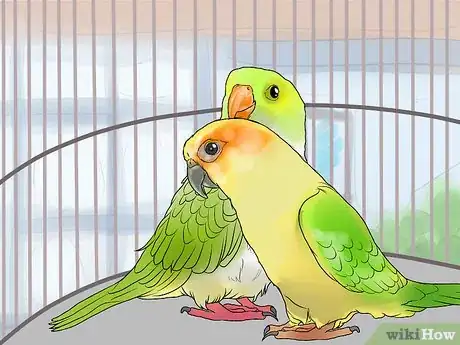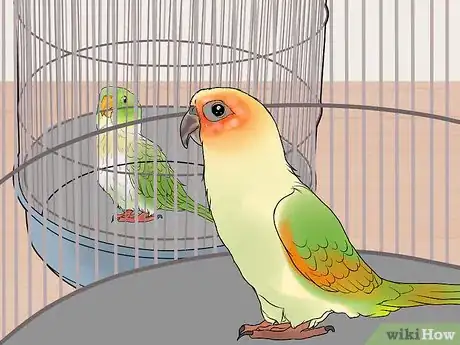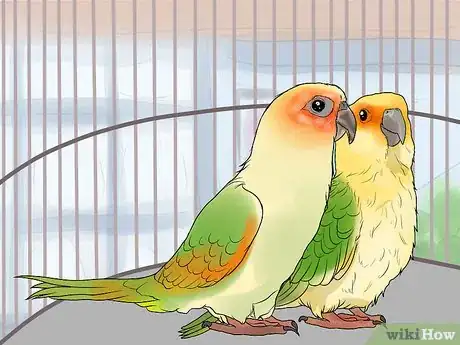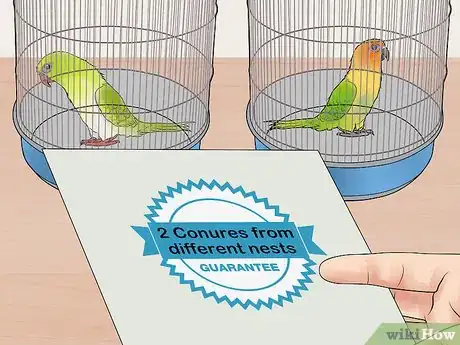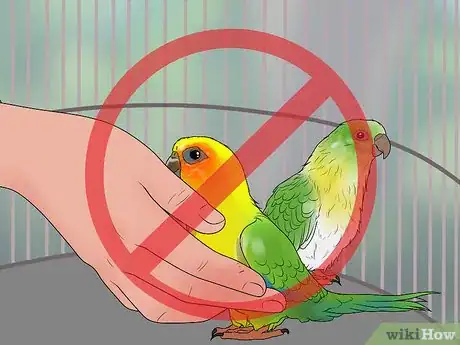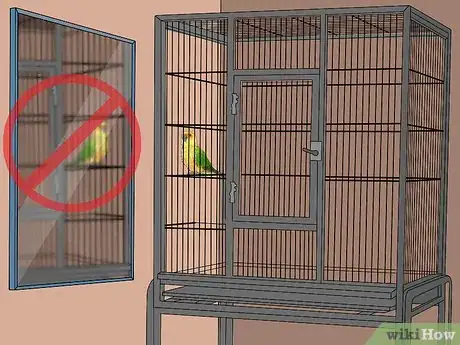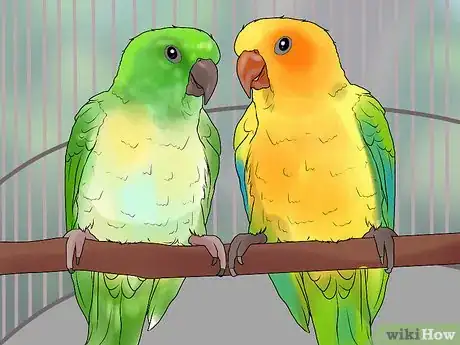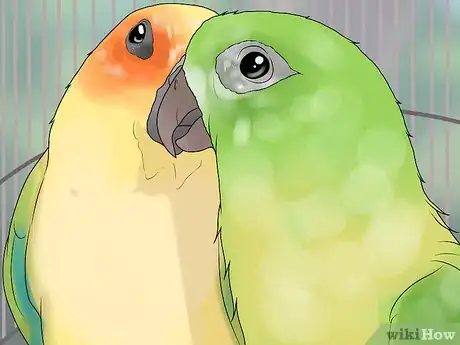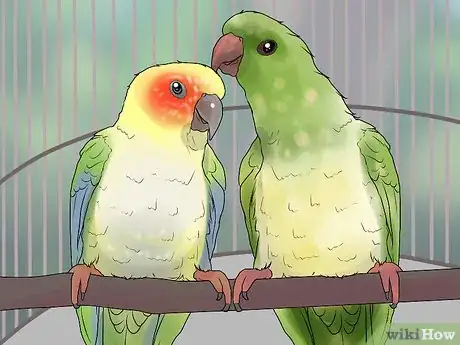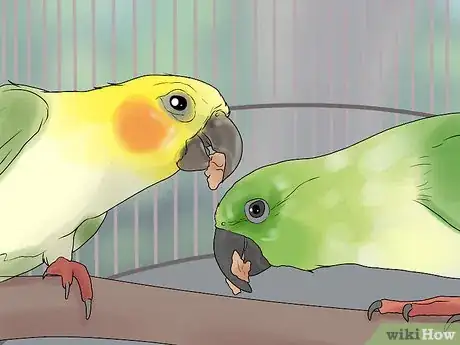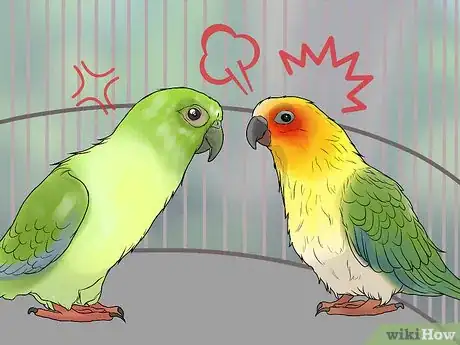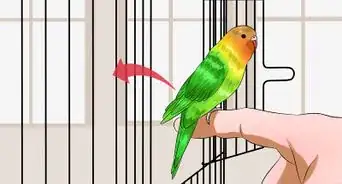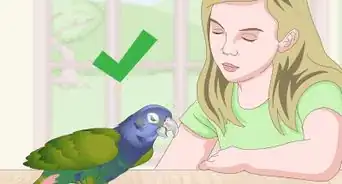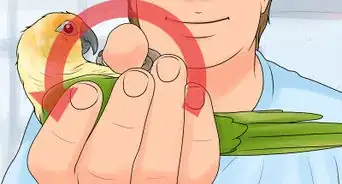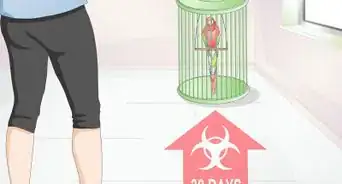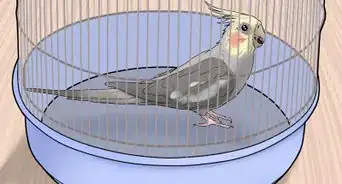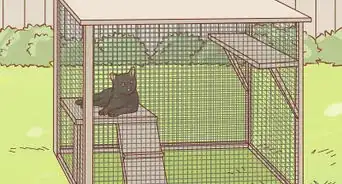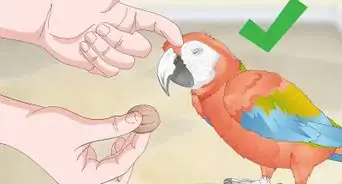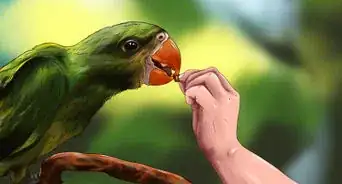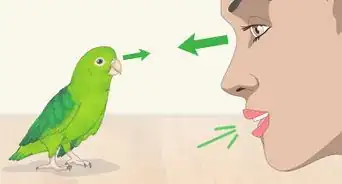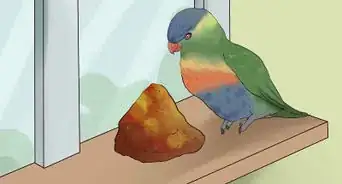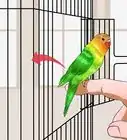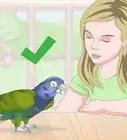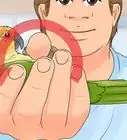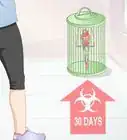This article was co-authored by Pippa Elliott, MRCVS. Dr. Elliott, BVMS, MRCVS is a veterinarian with over 30 years of experience in veterinary surgery and companion animal practice. She graduated from the University of Glasgow in 1987 with a degree in veterinary medicine and surgery. She has worked at the same animal clinic in her hometown for over 20 years.
There are 12 references cited in this article, which can be found at the bottom of the page.
This article has been viewed 53,722 times.
The most important part of bonding a pair of conures is housing them together. Housed together, the conures can get to know each other. You have a better chance of bonding a pair of conures if they are unrelated and close to each other in age. Additionally, give them privacy so that they focus on one another instead of on you. Keep in mind that bonded conures may become very distressed, sick, and depressed if they are separated, so it is important to always keep them together.[1]
Steps
Housing Your Conures
-
1Raise the birds together from an early age. If two conures are both relatively young (less than one year old) and have already been weaned, they can probably be placed together in a cage immediately. When the birds are raised together, they are more likely to think of each other as partners and companions.[2]
-
2Place birds who were not raised together from a young age in separate cages. When introducing birds who are a bit older (more than one year old), place them in two separate cages, but place the cages side-by-side. Look for signs of bonding, including sitting side-by-side, eating at the same time, or mutual head bobbing.[3]Advertisement
-
3Bring the bonded pair together in one cage. When bonding a conure pair that was not raised together, unite them in a neutral cage (not one of the cages they used individually) after detecting signs of bonding. This will reinforce the bond between them.[4]
- Since a single conure requires an enclosure 24″ wide x 24″ deep x 30″ high ( 61 cm x 61 cm x 76 cm), two conures should be housed together in an enclosure with dimensions twice as large.[5]
Ensuring a Strong Bond
-
1Purchase unrelated birds. Birds who are related might have a more difficult time bonding. When purchasing your birds, choose a qualified seller who offers written guarantees that the two conures are from different nests.[6]
-
2Obtain birds that are the same age. If one bird in a pair is of a different age than the other, it might try to take on an “alpha” role in the pair, which could cause it to act aggressively. To increase odds of a successful bonding, match two birds that are the same age or close to the same age.[7]
-
3Don’t bother your conures. The more you interact with your conures, the less interested they will be in each other. To encourage bonding, minimize your contact with them by only visiting to provide food.
- This rule also applies if you want to breed your conures. Stay away from them until they’ve produced an egg.
-
4Keep mirrors away from the cage. If a conure sees its image in a mirror, it could become confused and begin bonding with its reflection. Therefore, don’t place mirrors or toys that include mirrors in or near the conure cage.[8]
Identifying Signs of Bonding
-
1Look for the pair sitting together. When birds sit next to each other, it means that they like each other. Provide perches and stands in the conures’ cage so they can sit near each other.[9] If you notice the birds nestling up to each other and mirroring each other’s actions, then this is a good indication that they have bonded.
-
2Keep an eye out for rapid head bobbing. If your conures rapidly bob their heads up and down when interacting, it means they like each other. You might see this behavior with same-sex conure pairs or in male-female pairs.[10]
-
3Look for tongue touching. Conures have sensitive tongues and often examine objects or birds with them. Curious or affectionate conures might press their tongues against their companion.[11]
-
4Check for preening. Conure friends often lick, nibble, or gently pull at each other’s feathers. These behaviors help the bird on the receiving end keep its feathers properly oiled and groomed, and protect it from water and cold. This social behavior is an indicator that your birds are getting along.[12]
-
5Look for the pair eating together. When your conure pair share feeding habits, you’ll know they’ve really hit it off. Conure friends might bring food back to a shared perch or cluster around a single food dish and eat together. If the birds are of different sexes, one might feed the other (either directly or by chewing the food and then regurgitating it into the other’s mouth).[13]
-
6Expect the occasional squabble. Although bonded conures are devoted to each other, they may occasionally squabble. However, they will usually sort things out on their own and you will not need to intervene.
References
- ↑ http://greencheekconure.net/2012/10/green-cheek-conure-bonding.html
- ↑ http://www.birdsnways.com/wisdom/ww24evi.htm
- ↑ http://www.birdsnways.com/wisdom/ww24evi.htm
- ↑ http://www.thatpetplace.com/sun-conures-article
- ↑ https://www.earthsfriends.com/jenday-conure/
- ↑ http://www.birdsnways.com/wisdom/ww24evi.htm
- ↑ http://www.birdsnways.com/wisdom/ww24evi.htm
- ↑ http://www.thatpetplace.com/sun-conures-article
- ↑ http://animals.mom.me/two-parakeets-like-other-4891.html
- ↑ https://books.google.com/books?id=sYu6tLYy6rAC&lpg=PA118&pg=PA117#v=onepage&q&f=false
- ↑ https://books.google.com/books?id=sYu6tLYy6rAC&lpg=PA118&pg=PA117#v=onepage&q&f=false
- ↑ http://animals.mom.me/two-parakeets-like-other-4891.html
- ↑ http://animals.mom.me/two-parakeets-like-other-4891.html
- ↑ http://www.birdsnways.com/wisdom/ww24evi.htm
- ↑ http://greencheekconure.net/2012/10/green-cheek-conure-bonding.html
- ↑ http://greencheekconure.net/2012/10/green-cheek-conure-bonding.html
About This Article
To successfully bond a pair of conures, put them in the same cage together if they're both less than 1 year old, since young conures will naturally bond if they're raised together. However, if your conures are older than 1 year and they weren't raised together, you should keep them in separate cages at first so they don't fight. Place the cages next to each other, and give your conures time to get used to each other. Once they show signs of bonding, like sitting near each other, eating at the same time, or bobbing their heads together, you can move them into the same cage. For advice from our Veterinary co-author, including how to tell if your conures are getting along in the cage together, keep reading!
